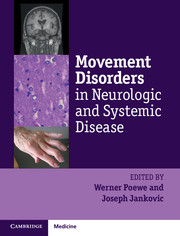Book contents
- Frontmatter
- Contents
- List of contributors
- List of videos
- List of abbreviations
- Preface
- Section I General principles
- Section II Movement disorders in systemic disease
- Section III Iatrogenic and toxic movement disorders
- Section IV Movement disorders in general neurology
- Chapter 17 Movement disorders in stroke
- Chapter 18 Movement disorders in multiple sclerosis
- Chapter 19 Movement disorders in neoplastic brain disease
- Chapter 20 Movement disorders in encephalitis
- Chapter 21 Sleep-related movement disorders
- Chapter 22 The borderland between epilepsy and movement disorders
- Chapter 23 Movement disorders associated with neuromuscular disorders and peripheral neuropathies
- Section V Systemic complications of movement disorders
- Index
- Plate Section
- References
Chapter 17 - Movement disorders in stroke
from Section IV - Movement disorders in general neurology
Published online by Cambridge University Press: 05 April 2014
- Frontmatter
- Contents
- List of contributors
- List of videos
- List of abbreviations
- Preface
- Section I General principles
- Section II Movement disorders in systemic disease
- Section III Iatrogenic and toxic movement disorders
- Section IV Movement disorders in general neurology
- Chapter 17 Movement disorders in stroke
- Chapter 18 Movement disorders in multiple sclerosis
- Chapter 19 Movement disorders in neoplastic brain disease
- Chapter 20 Movement disorders in encephalitis
- Chapter 21 Sleep-related movement disorders
- Chapter 22 The borderland between epilepsy and movement disorders
- Chapter 23 Movement disorders associated with neuromuscular disorders and peripheral neuropathies
- Section V Systemic complications of movement disorders
- Index
- Plate Section
- References
Summary
Introduction
Stroke is the second leading cause of death in industrialized nations and the most important cause of permanent neurological disability in the elderly. According to recent WHO estimates, stroke ranks second after dementia in the overall burden of disease from brain disorders and accounts for about 4.1 percent of all cause burden of disease (Murray et al. 2012). Prevalence of stroke rises with advancing age and beyond the age of 70 annual stroke incidence rises to above 2,000 per 100,000 (Diaz-Guzman et al. 2012; Kissela et al. 2012; Khellaf et al. 2010; Warlow et al. 2003). Approximately 85 percent of all strokes are ischemic in nature, while 15 percent result from intracerebral hemorrhage. Arteriosclerosis is the single most important cause of ischemic stroke, either via large or small vessel disease or combinations followed by embolic stroke from cardiac sources. Stroke symptoms depend on the anatomic location of brain infarcts or hemorrhages and the functional connectivity of lesion sites. Involvement of the basal ganglia and their afferent and efferent connections is very common in strokes affecting the middle cerebral artery territory, and yet movement disorders seem to be relatively rarely reported in the context of stroke. This may be partially due to observer bias with focus on acute stroke symptoms and acute management, while in many cases movement disorders only develop after acute stroke symptoms have resolved. Also, the distinction between vascular “look-alikes” of common degenerative movement disorders and their bona fide counterparts can be challenging, as probably best exemplified by the controversies and uncertainties related to vascular parkinsonism.
Mechanisms underlying stroke-related movement disorders
Dysfunctional sensorimotor integration is the common final pathophysiological pathway for all movement disorders and the neural networks involved include motor loops interconnecting the cerebellum, brainstem nuclei, basal ganglia, thalamus, and motor and pre-motor cortical areas (Abbruzzese and Berardelli 2003).
- Type
- Chapter
- Information
- Movement Disorders in Neurologic and Systemic Disease , pp. 247 - 267Publisher: Cambridge University PressPrint publication year: 2014



